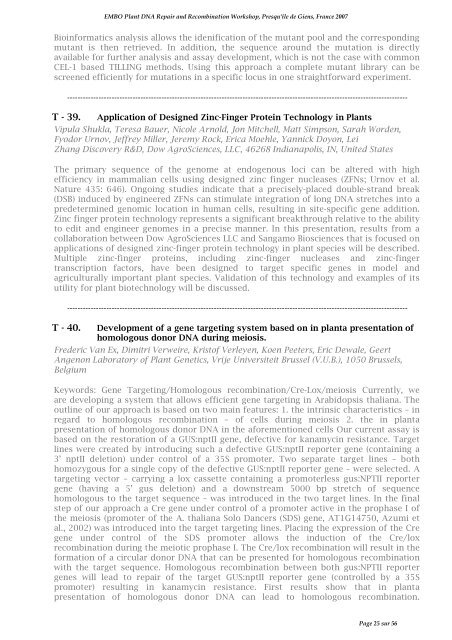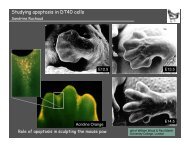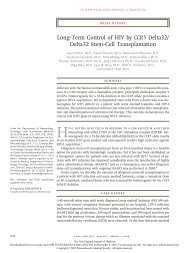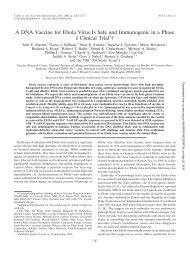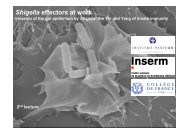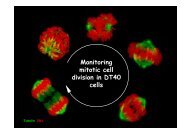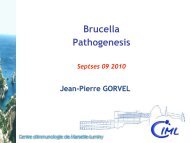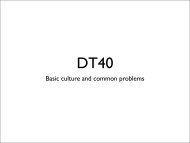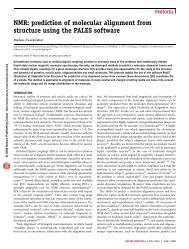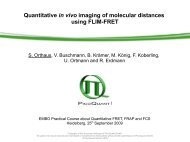pdf file - Events - EMBO
pdf file - Events - EMBO
pdf file - Events - EMBO
You also want an ePaper? Increase the reach of your titles
YUMPU automatically turns print PDFs into web optimized ePapers that Google loves.
<strong>EMBO</strong> Plant DNA Repair and Recombination Workshop, Presqu'île de Giens, France 2007<br />
Bioinformatics analysis allows the idenification of the mutant pool and the corresponding<br />
mutant is then retrieved. In addition, the sequence around the mutation is directly<br />
available for further analysis and assay development, which is not the case with common<br />
CEL-1 based TILLING methods. Using this approach a complete mutant library can be<br />
screened efficiently for mutations in a specific locus in one straightforward experiment.<br />
----------------------------------------------------------------------------------------------------------------------------------<br />
T - 39. Application of Designed Zinc-Finger Protein Technology in Plants<br />
Vipula Shukla, Teresa Bauer, Nicole Arnold, Jon Mitchell, Matt Simpson, Sarah Worden,<br />
Fyodor Urnov, Jeffrey Miller, Jeremy Rock, Erica Moehle, Yannick Doyon, Lei<br />
Zhang Discovery R&D, Dow AgroSciences, LLC, 46268 Indianapolis, IN, United States<br />
The primary sequence of the genome at endogenous loci can be altered with high<br />
efficiency in mammalian cells using designed zinc finger nucleases (ZFNs; Urnov et al.<br />
Nature 435: 646). Ongoing studies indicate that a precisely-placed double-strand break<br />
(DSB) induced by engineered ZFNs can stimulate integration of long DNA stretches into a<br />
predetermined genomic location in human cells, resulting in site-specific gene addition.<br />
Zinc finger protein technology represents a significant breakthrough relative to the ability<br />
to edit and engineer genomes in a precise manner. In this presentation, results from a<br />
collaboration between Dow AgroSciences LLC and Sangamo Biosciences that is focused on<br />
applications of designed zinc-finger protein technology in plant species will be described.<br />
Multiple zinc-finger proteins, including zinc-finger nucleases and zinc-finger<br />
transcription factors, have been designed to target specific genes in model and<br />
agriculturally important plant species. Validation of this technology and examples of its<br />
utility for plant biotechnology will be discussed.<br />
----------------------------------------------------------------------------------------------------------------------------------<br />
T - 40. Development of a gene targeting system based on in planta presentation of<br />
homologous donor DNA during meiosis.<br />
Frederic Van Ex, Dimitri Verweire, Kristof Verleyen, Koen Peeters, Eric Dewale, Geert<br />
Angenon Laboratory of Plant Genetics, Vrije Universiteit Brussel (V.U.B.), 1050 Brussels,<br />
Belgium<br />
Keywords: Gene Targeting/Homologous recombination/Cre-Lox/meiosis Currently, we<br />
are developing a system that allows efficient gene targeting in Arabidopsis thaliana. The<br />
outline of our approach is based on two main features: 1. the intrinsic characteristics – in<br />
regard to homologous recombination – of cells during meiosis 2. the in planta<br />
presentation of homologous donor DNA in the aforementioned cells Our current assay is<br />
based on the restoration of a GUS:nptII gene, defective for kanamycin resistance. Target<br />
lines were created by introducing such a defective GUS:nptII reporter gene (containing a<br />
3’ nptII deletion) under control of a 35S promoter. Two separate target lines – both<br />
homozygous for a single copy of the defective GUS:nptII reporter gene – were selected. A<br />
targeting vector – carrying a lox cassette containing a promoterless gus:NPTII reporter<br />
gene (having a 5’ gus deletion) and a downstream 5000 bp stretch of sequence<br />
homologous to the target sequence – was introduced in the two target lines. In the final<br />
step of our approach a Cre gene under control of a promoter active in the prophase I of<br />
the meiosis (promoter of the A. thaliana Solo Dancers (SDS) gene, AT1G14750, Azumi et<br />
al., 2002) was introduced into the target targeting lines. Placing the expression of the Cre<br />
gene under control of the SDS promoter allows the induction of the Cre/lox<br />
recombination during the meiotic prophase I. The Cre/lox recombination will result in the<br />
formation of a circular donor DNA that can be presented for homologous recombination<br />
with the target sequence. Homologous recombination between both gus:NPTII reporter<br />
genes will lead to repair of the target GUS:nptII reporter gene (controlled by a 35S<br />
promoter) resulting in kanamycin resistance. First results show that in planta<br />
presentation of homologous donor DNA can lead to homologous recombination.<br />
Page 25 sur 56


